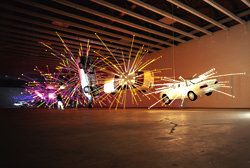I went to an open house on Queen Anne not long ago, not because I was interested in buying the three-bedroom, no-backyard charmer, but to see the art.
A large Michael Schultheis painting hung in the foyer; evocative black-and-white photos graced the dining room. In another house that I was actually considering purchasing, I came across an abstract canvas by Drake Deknatel and yet another Schultheis, almost distracting me from the weird fir inlay marring the oak floors and the cheap built-ins of the living room. Almost.
In both instances, it was not the fine taste of the seller I was being seduced by, but that of the home stager—the person who decorates empty houses in order to make them more appealing to buyers, theoretically increasing the selling price. Home staging is a trend that’s been around at least 10 years in the hot real-estate markets of San Francisco and Los Angeles, and is now keeping up to 20 different enterprises in business here in Seattle. Using original art rather than inexpensive pastoral prints is the newest twist.
In Seattle, if you see high-quality local art in a staged house, chances are good the person who put it there is Jan Sewell. A Windermere real-estate agent for 13 years, Sewell got into staging in 1997 and now has five employees. She is also a genuine art lover with an extensive private collection of local art and friends in the art community. “I really wanted to support local artists,” says Sewell. But her business rationale for using real art is clear: “I think most people associate original artwork with higher-end product. It increases perception of value.
“In my approach to staging, a lot of it is reaching people on a subliminal level, and I think art really does that,” says Sewell, who charges anywhere from $2,800 to $15,000 to spiff up a house, depending on the size of the space she needs to transform.
Another beneficiary of the growing trend in home staging and one of Sewell’s main sources for art is Seattle Art Museum’s Rental Sales Gallery, which both sells and rents original work from local galleries. “That [business] has increased spectacularly,” says gallery director Barbara Shaiman. Sewell is probably Shaiman’s biggest client.
While it’s an unexpected pleasure to come across good art during the sometimes grueling task of home searching, I couldn’t help wondering how artists feel about their original creations being, well, pimped in this calculated and commercial way. Schultheis shrugs it off. He says he’s all for “bringing really amazing art into places where art might not normally be. Because sometimes people would never have a chance to see the work [of those artitsts].”
All of this leads to the inevitable question: What kind of art is suitable for home staging? Do home stagers choose only what’s safe, bland, or “decorative”? “They’re not going to have nudes or nasty things about the pope,” Shaiman says. “But I wouldn’t say ‘safe.’ Some are interested in contemporary art, not just what looks nice over the couch.”
Sewell agrees. She once placed ceramic glove sculptures in a house in Wedgwood and promptly got complaints from the selling agent, who declared, “People are scared of the hands!” She ran into a similar problem with her African mask collection. So she keeps the more provocative work on her own walls. While Sewell loves the mock-Americana paintings of Jane Richlovsky, for example, she feels “she is too satirical for stages.”
Instead, Sewell tends toward mostly abstract and some figurative work. Schultheis and the late Deknatel are two of her favorite artists for home staging. Schultheis’ lush abstractions enhance entrances and hang nicely over fireplaces, their elaborate mathematical equations passing as mere decoration, no doubt. Deknatel’s bold, nonfigurative work is probably easier to incorporate into a design “vignette” than his more somber and striking soldier series, which also tends to be quite large. Deborah Bell’s whimsical and colorful mixed-media abstract panels are another Sewell favorite, as are Jenny Beedon-Snow’s romantic suburban-scapes and the pretty floating geometric shapes of local print artist Barbara Robertson.
But the art shouldn’t steal the show, says Sewell, who has “been to houses where I am so taken up with the artwork I didn’t see the house at all!” (Yet surely there’s an added advantage if the art can distract an inattentive buyer from a house’s flaws.)
While Sewell claims that staging “makes [sellers] a ton of money,” she can’t put an empirical value on the service she offers. But she has anecdotal evidence of houses that stagnated on the market and then suddenly became the objects of bidding wars once she’d stepped in.
Whatever the case, adding real art to the faux decor of home staging creates another venue for artists to make a bit of money from their work, at least in rentals, and allows the public to see art more easily. A tour of weekend open houses in any of Seattle’s trendier urban neighborhoods might yield some special discoveries. And home buyers do sometimes have the option to buy the work along with the house. Reminds Shaiman, “If you buy the house and like the piece, it’s worth asking.”








